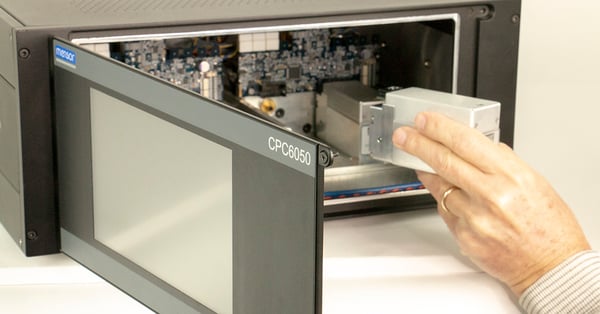Why are interchangeable pressure transducers and multiple output channels so important when evaluating the most efficient and cost effective solutions for pressure calibration laboratories or production testing?
Modular ranges and multiple channels results in better coverage. Why?
When calibrating any pressure device, the pressure standard must be more accurate than the device being calibrated. A generally accepted rule of thumb is that the standard should be four times more accurate than the device under test (DUT). A calibration that satisfies this rule is said to have a "Test Accuracy Ratio" of 4 to 1 (TAR of 4:1). The standard must also have a range that encompasses the range of the DUT. For example, a 70 psi DUT cannot be fully calibrated using a 50 psi standard. In addition, the standard and the DUT must be operating in the same pressure mode - gauge, absolute or bidirectional.
The accuracy of any given standard or DUT can be expressed as a percent (%) of "Full Scale" or of "Reading." If all the ranges and accuracies of the DUTs are known, choosing the pressure ranges for the standard is simply a process of comparing the accuracy and range of both the standard and the DUTs.
If the following equation is true, then the accuracy of the standard is acceptable under the 4:1 rule:
As* Rs * 4 ≤ ADUT * RDUT
To find the required accuracy of the standard:
As ≤ ADUT * RDUT / Rs * 4
Where: As = Accuracy of the Standard
Rs = Range of the Standard
ADUT = Accuracy of the DUT
RDUT = Range of the DUT
The selection of the most efficient standard range only becomes complicated when the DUTs have multiple ranges, different pressure modes and/or a wide variety of accuracy specifications. In many instances, several ranges can be calibrated by a single standard range as long as the accuracy and range of each calibrated sensor satisfies the 4:1 TAR rule. However as the accuracy requirements of the DUTs become better, the 4:1 TAR will inevitably require more ranges or better accuracy from the standard. When the standard has the capability to have multiple and interchangeable transducers in a modular package, the value and applicability of a single instrument becomes apparent. With high accuracy interchangeable transducer ranges, most, if not all, TAR requirements can be met with one device.
As a result, manufacturers have gone away from simple, single range pressure standards. Now they use standards with multiple and interchangeable ranges, and multiple and independent pressure channels to cover as many DUT ranges as possible. Independent channels make it possible to conduct two calibrations simultaneously or consecutively with the same pressure calibrating controller instrument. One channel could contain a 6000 and a 3000 psia transducer and the other channel could contain a 100 and a 50 psig sensor. This would allow a gauge calibration with one channel and an absolute calibration with the other. In addition, transducer ranges can be swapped for one another to cover various DUT ranges.

Getting the widest coverage is key in choosing the right pressure calibration standard. The most efficient pairing of standard to DUT may require consultation with a factory sales engineer.
Share the details of your application and we will contact you with an engineered solution.
Mensor has a wide variety of modular pressure controlling calibrators with interchangeable pressure ranges and independent pressure controlling channels.
Related Reading:


